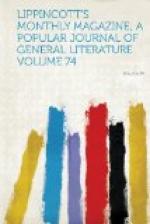Then comes the Tuscan Morpheus, creepy,
crawly,
With poppies and with lettuce crowned.
These lines, however, represent pretty accurately about the worst that his subjects had to say of poor old “Ciuco,” as the last of the grand dukes was irreverently and popularly called: “Ciuco,” I am sorry to state, means “donkey.” And it must be owned that the two lines I have quoted from Giusti’s verses, with their untranslatable “lemme, lemme”—of which I have endeavored, with imperfect success, to give the meaning—present a very graphic picture of the man and the nature and characteristics of his government. Everything went “lemme, lemme,” in the Sleepy Hollow of Tuscany in those days.
Used as he was to be laughed at, Leopold could occasionally be made sleepily half angry by impertinences which had something of a sting in them. Here is an amusing instance of that fact, and of the way in which things used to be done in Tuscany. Most of the Italian provinces—or larger cities, rather—have been from time immemorial personated in the popular fancy by certain comic types, supposed to represent with more or less accuracy the special characteristics of each district. Venice, as all the world knows, has, and still more had, her “Pantaloon,” Naples her “Pulcinello,” etc. The specialties of the Florentine character are popularly supposed to be embodied in “Stenterello,” who comes on the Florentine stage, in pieces written for the purpose, every Carnival, to the never-failing delight of the populace. Stenterello is an absurd figure with a curling pigtail, large cocked hat, and habiliments meant to represent those of a Tuscan citizen of some hundred years or so ago. He is a sort of shrewd fool, doing the most absurd things, lying through thick and thin with a sort of simple, self-confuting mendacity, yet contriving to cheat everybody, and always having, amid all his follies, a shrewd eye to his own interest. He talks with the broadest possible Florentine accent and idiom, and despite his cunning is continually getting more kicks than halfpence. Well, there was in those days a famous Stenterello, really a very clever fellow in his way, who for many years had been the delight of the Florentines every Carnival. But one year a rival theatre produced a new and rival Stenterello. Of course the old and established Stenterello could not stand this without using the license of the popular stage to overwhelm his rival with ridicule. “This sort of thing,” said he, “will never do! How many Stenterelli are we to have? Two is the regular established number in Florence. There are I and my brother over there at the great house on the other side of the Arno: we are the Florentine Stenterelli by right divine, as is well known. Who is this pretender who comes to interfere with us?” etc. Now, this was a little too much, even for Florence. And a day or two afterward the old original Stenterello was ordered to go to prison. Nobody was ever




